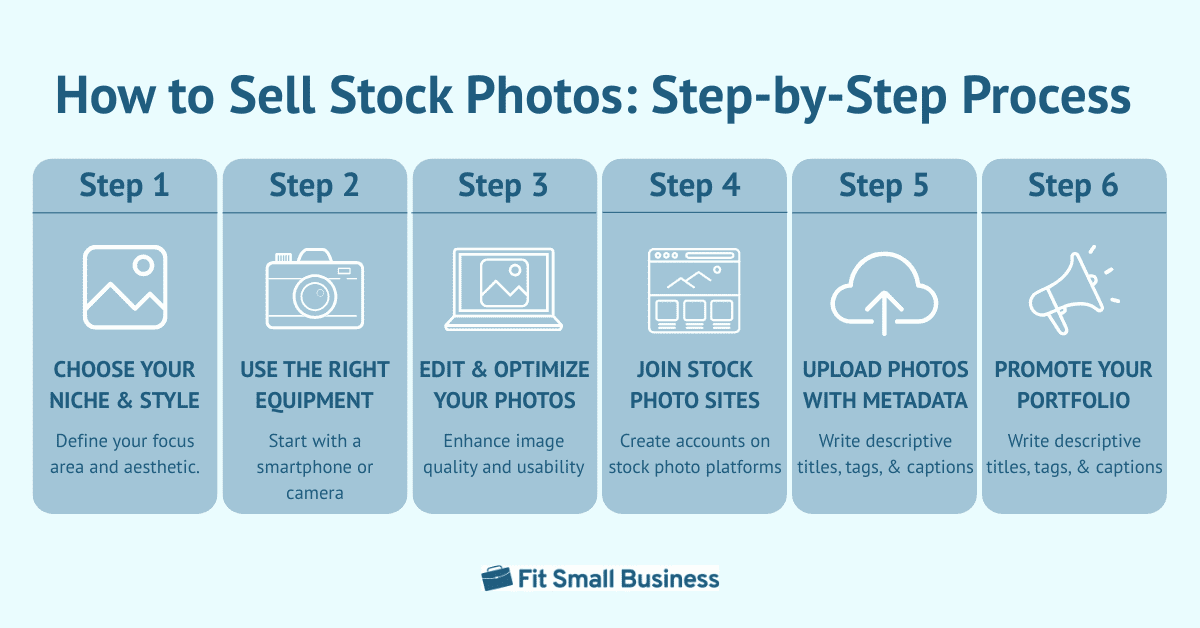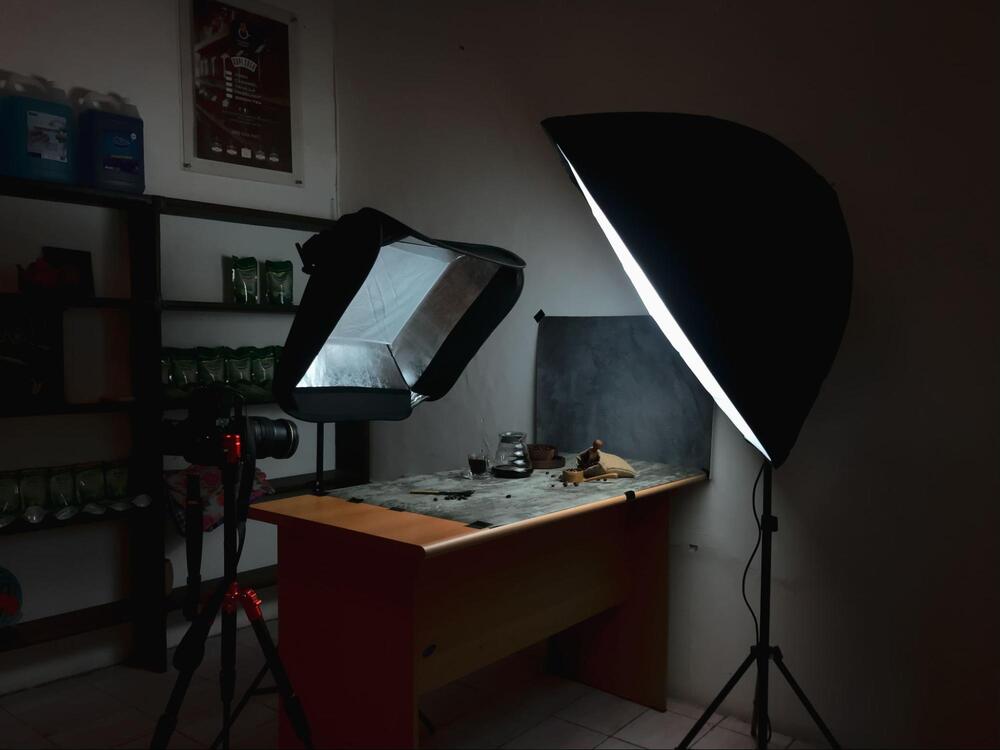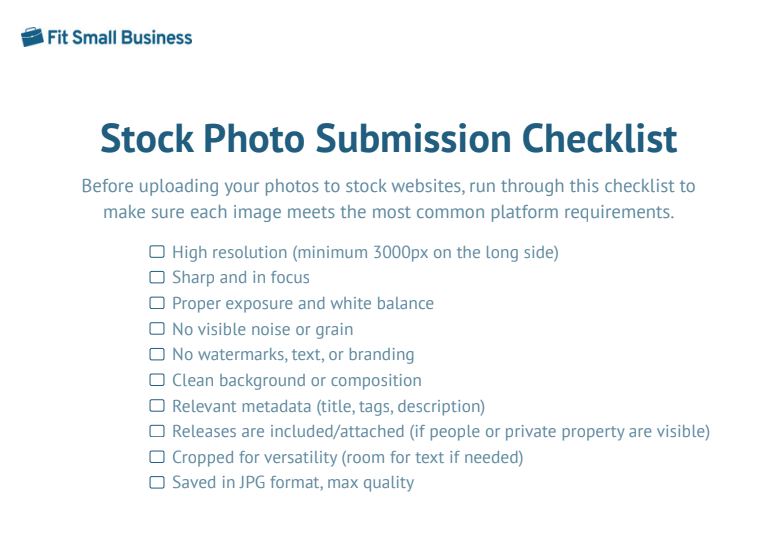Wondering if selling stock photos is still worth it in 2025? Short answer: Yes – but only if you know how to do it right.
How to Sell Stock Photos: What Actually Works in 2025
You can make money selling your photos online, but success depends on choosing the right platforms, knowing what types of images buyers want, and uploading consistently with solid metadata. Whether you’re using a DSLR or just your phone, there’s real potential to earn passive income if you treat it like a business.
In this guide, I’ll show you detailed steps on how to sell stock photos online, where to upload them, what gear you need (hint: it doesn’t have to be fancy), and how to boost your chances of getting downloads — and dollars.

Ready to turn your photos into profit? Here’s exactly how to sell stock photos, from picking your niche to getting your images in front of paying buyers. Follow these steps to build a portfolio that stands out and starts earning.
Step 1: Choose your niche and style
Before you start taking and uploading photos, take time to define your niche. Are you into lifestyle photography? Food? Tech? Nature? Narrowing your focus helps you build a consistent portfolio and gives buyers a clear reason to choose your work.
Your “style” matters too. Are your photos light and airy? Dark and moody? Clean and minimal? Creating a recognizable look helps your images stand out on crowded stock sites.
Top-selling stock photo categories
While developing your own style is key, it also helps to align it with what buyers are actually searching for. These categories consistently perform well across stock platforms, so finding your niche within them can boost your visibility and earnings.
- Business & work life: Offices, remote work setups, team meetings, entrepreneurs in action
- Lifestyle & people: Natural, candid shots of real people doing everyday things
- Health & wellness: Fitness, mental health, nutrition, self-care routines
- Technology: Devices, software use, coding, AI, digital workspaces
- Food & drink: Flat lays, styled meals, ingredients, coffee moments
- Travel & nature: Scenic landscapes, city shots, cultural experiences
- Holidays & celebrations: Seasonal themes, family gatherings, gift-giving
- Education & learning: Students, teachers, online learning, books
- Finance & money: Budgeting, saving, shopping, digital payments
You don’t have to cover everything — just pick a lane that matches your interests and start creating with those buyers in mind.
Step 2: Use the right equipment
You don’t need to drop thousands of dollars on gear to start selling stock photos. What matters most is image quality, not the price tag on your camera.
Smartphones vs DSLR
Equipment type | Best for | Use case examples |
|---|---|---|
Smartphones | Beginners, casual photographers, mobile content | Lifestyle shots, travel, social-style photos |
DSLR & mirrorless cameras | Pros, advanced users, high-end or technical photography | Studio work, product photos, low-light shoots |
Today’s smartphones are more than capable of shooting high-quality images, especially in natural light. If you’re just starting out, a newer iPhone, Samsung, or Pixel phone paired with good lighting and composition can produce photos that stock sites will accept. Just make sure your images are sharp, well-lit, and properly edited.
However, a DSLR or mirrorless camera is worth the investment if you want full creative control, better low-light performance, and the ability to shoot in RAW for advanced editing. These cameras give you higher resolution and depth of field, which is helpful for more technical or commercial-style shoots.
Bottom line? Start with what you have and upgrade when you’re ready. Stock photo buyers care more about the content and quality of the photo than what you shot it with.
Accessories
You don’t need a full studio setup to take great stock photos, but a few affordable accessories can seriously improve your results. Here are some options when you’re ready to take your stock photography to a higher level.
Step 3: Edit and optimize your photos
Before you upload anything, you need to clean up and prep your photos for stock sites. Even the best shot can get rejected if it’s poorly lit, has noise, or isn’t sized correctly.
Stock platforms are picky — and for good reason. They want sharp, well-composed, versatile images that buyers can use right away. That means you’ll need to edit your photos for both quality and usability.
Basic stock photo editing tips
You don’t have to go overboard, but here are a few things to look for:
- Adjust exposure and contrast: Make sure the image is bright, but not blown out.
- Fix white balance: Keep colors true-to-life unless you’re going for a specific mood.
- Crop thoughtfully: Leave space for copy/text when possible — buyers love flexibility.
- Remove distractions: Clean up background clutter or blemishes using spot-heal tools.
- Sharpen: But don’t overdo it. Stock sites will reject images that look over-processed.
- Stay natural: Don’t add heavy filters or editing styles that reduce usability.
Use tools like Lightroom, Snapseed, or VSCO for quick edits — no Photoshop degree required.
Stock photo requirements checklist free download
Want to avoid getting your photos rejected by stock sites? Use this quick checklist to make sure every image you upload meets the most common submission standards. Download it, keep it handy, and use it as your pre-upload ritual.
Step 4: Create accounts on stock photo sites
Once your photos are edited and ready to go, it’s time to choose where to sell them. Most photographers upload to multiple platforms to increase their chances of making sales. Just be sure to read each site’s guidelines — they all have slightly different requirements.
Best platforms to sell stock photos online
There’s no shortage of stock photo sites, but not all are created equal. Some are beginner-friendly with quick approval, while others cater to pros with premium content. You can (and should) submit to more than one, but it helps to know what each platform is best at.
Here’s a quick comparison of the top stock photo sites to help you decide where to start:
Platform | Best for | Contributor requirements | Payout info | Notes |
|---|---|---|---|---|
Shutterstock | Beginners, high-volume contributors | Easy to join, fast approval | Starts at 15%-40% per download | Large buyer base, steady volume |
Adobe Stock | Beginners, creatives using Adobe tools | Adobe ID required, simple upload process | 33% commission | Integrates with Lightroom and Photoshop |
Getty Images | Pros, commercial & editorial work | Selective, portfolio review needed | High payout, exclusive images earn more | Known for premium clients and usage |
iStock (by Getty | Mid-level to advanced contributors | Easier entry than Getty; non-exclusive allowed | 15%-45% depending on exclusivity | Good exposure, part of Getty network |
Alamy | Niche photos, editorial content | Flexible, wide range of accepted content | 40% commission (non-exclusive) | Higher pricing, slower volume |
EyeEm | Mobile photographers, artsy/trend-driven shots | App-based upload, moderate approval process | 50% commission (if licensed via EyeEm Market) | Great for lifestyle and creative work |
Other stock photo sites to consider are:
- Envato Elements
- Blackbox
- Pond5
- Depositphotos
- 123RF
- Dreamstime
- Freepik
- BigStockPhoto
Understanding pricing and licensing models
When you sell photos as stock images, you don’t set the price — the platform does. But understanding how pricing and licensing work can help you choose the right sites and make smarter upload decisions.
Royalty-free vs rights-managed
The most common model is the royalty-free model. Buyers pay once and can use the image multiple times (with some restrictions). You keep earning every time someone downloads it. This pricing model is best for passive income and higher volume sales.
On the other hand, with the rights-managed model, the buyer pays for specific usage — like location, duration, or number of impressions. These images sell for more, but fewer buyers opt for them. This pricing model is best for exclusive or high-end content.
How payouts work
Most platforms pay you a percentage of the sale price, and that cut varies depending on the platform and your contributor status. For example, Shutterstock starts at 15% and increases as you hit download milestones. Adobe Stock offers a flat 33%, while Getty Images and iStock have tiered rates based on whether your content is exclusive. Alamy pays up to 40% for non-exclusive contributors, and EyeEm offers 50% if your photo sells through their marketplace. The more you contribute — and the more consistently you sell — the better your long-term earning potential.
Pro tip: Don’t go exclusive (at first)
Some platforms offer higher rates if you submit content exclusively to them — but that limits your reach. If you’re just starting out, keep your photos non-exclusive so you can upload to multiple sites and learn what performs best.
Real-life earnings
One of the questions that often comes up when starting a business is, how much can I earn? Jason Yoder, a photographer selling stock photos, earned $212.82 for February 2025 and $313.97 for January 2025.
Another photographer, Peter Orsel, earned a total of $1,900 in his first year of selling stock photography in 2023. Based on his experience, he is earning around $0.04 to $0.06 per stock photo.
Step 5: Upload photos with accurate metadata
Once your images are ready, don’t just hit upload and hope for the best. What you write about your photo is just as important as the photo itself. That’s where metadata comes in — and it’s key to getting your stock photos discovered (and downloaded).
What is metadata?
Metadata is the behind-the-scenes info that helps buyers and stock site algorithms understand what your image is about. It usually includes:
- Title: A short, clear description of the image
- Tags/keywords: Words and phrases buyers might search for
- Description: A sentence or two that explains the subject and setting
Tips for writing better metadata
Metadata is what gets your photo found. Nail this part, and you’ll boost your visibility — along with your chances of getting paid. Here’s how to write it like a pro:
- Be specific: Instead of just “man,” try “young man working on laptop in a coffee shop.”
- Use all the keyword slots: Most platforms let you add 25 to 50 keywords. Use as many that make sense.
- Think like a buyer: Ask yourself, “What would someone type in if they were looking for this image?”
- Avoid keyword stuffing: Only use words that actually apply to the photo. Irrelevant tags can hurt your visibility.
- Include concept keywords: Words like “success,” “teamwork,” or “connection” help with commercial use.
Metadata might feel tedious, but it’s what makes your photo show up in search. The better your metadata, the more likely your image gets seen — and sold.
Step 6: Promote your portfolio
The work does not end when you upload your photos — promoting your portfolio is key if you want to actually sell your photos as stock images. You will need to get your photos seen by users. The more eyes on your work, the more chances you have to earn.
Here’s how to get your photos in front of the right people:
- Share your work on social media. Use platforms like Instagram, Pinterest, and LinkedIn to share your best shots. Add behind-the-scenes content or editing tips to keep it engaging. Always link back to your stock profile or specific images.
- Create a simple portfolio website. A basic site or landing page showcasing your best work makes you look professional and gives you a central hub to drive traffic to your stock photo profiles.
- Add links to your email signature. Every email you send is a chance to get eyes on your work. Drop a line like, “See my stock photography portfolio,” with a link.
- Use SEO on your portfolio pages. If you’re hosting images on your own site, use descriptive titles, alt text, and captions. The same way you would think like your buyers when writing your metadata, ask yourself what they would search for.
- Submit to stock photo roundups. Some blogs and brands curate “Best Free Stock Photo” or “Top Contributors on [Platform]” lists. Reach out and pitch your work for inclusion.
- Collaborate with creators. Partner with bloggers, small businesses, or influencers who need stock photos. Offer a few images in exchange for credit and a link to your portfolio.
Why sell stock photos?
Unlike client photography, where you shoot for a one-time fee, stock photos can earn you passive income over and over again. You upload once, and each download puts money in your pocket.
If you’re a photographer, content creator, or just someone who loves taking photos, selling stock images online is a low-barrier, flexible way to make extra income. Here are a few benefits of selling stock photography:
- You can earn while you sleep: Each download puts money in your pocket, no extra work required.
- You don’t need fancy gear: A decent phone camera and good lighting can go a long way.
- It’s location-independent: Shoot, upload, and sell from anywhere.
- You improve your skills: Learn what sells, sharpen your editing, and build a portfolio.
- It fits into your schedule: You control when and how much you upload.
Tips to make more money selling stock photos
Once you’ve got the basics down, it’s time to level up. These tips will help you increase your visibility, boost downloads, and actually make money selling stock photos — not just upload and hope.
- Upload consistently. Stock photo platforms reward active contributors. Make it a habit to upload regularly, even just a few images a week. The more content you have, the more chances you have to get found and earn.
- Follow seasonal and trending topics. Think ahead — start uploading holiday content months in advance. Watch for trending themes like remote work, AI, sustainability, or social movements. Stock photo buyers love fresh, timely visuals.
- Shoot for commercial use. Always ask: “Could a brand or blog use this in marketing or content?” Images that convey ideas like success, teamwork, health, or lifestyle tend to sell more because they’re versatile and message-driven.
- Use strategic metadata. Yep, it’s worth repeating. Strong titles, detailed descriptions, and relevant keywords can make or break your photo’s visibility. Always fill them out thoughtfully.
- Focus on quality over quantity. It’s tempting to upload everything, but only your best work should go live. Platforms (and buyers) prefer clean, well-composed images that clearly tell a story.
- Diversify your portfolio. Cover a range of subjects, styles, and concepts. Mix people shots with still life, indoors with outdoors, and natural light with artificial. This helps you reach more buyers across more categories.
- Track what sells. Most stock platforms show you download stats. Pay attention. If your “coffee and laptop” shots sell like crazy, shoot more in that niche — and build around what’s already working.
Making money with stock photography takes time and intention, but if you treat it like a business, the results will follow.
AI in stock photography: What creators need to know
AI-generated images are shaking up the stock photo industry. Tools like Midjourney, DALL·E, and Firefly make it possible to create stunning visuals in seconds, and stock platforms are starting to take notice. But what does that mean for photographers selling real images?
Here’s what you need to know about selling stock photos in an AI-driven world.
Can you sell AI-generated photos as stock?
The short answer is yes, but only on certain platforms — and only if you follow the rules.
Adobe Stock, Shutterstock, and a few others allow AI-generated content, but you must clearly label it and follow their technical and ethical guidelines. These platforms require that AI images be original, high-quality, and free of copyrighted or trademarked elements.
If you’re experimenting with AI art, read each site’s contributor terms carefully before uploading. Mislabeling AI content or using protected likenesses could get your account flagged or banned.
How AI impacts traditional stock photographers
AI is quickly filling platforms with generic, stylized visuals, especially in categories like abstract, futuristic, or concept art. But here’s the good news: there’s still strong demand for authentic, relatable, real-world content.
Buyers still want:
✅Real people in real situations
✅Diverse and inclusive imagery
✅Emotion, storytelling, and lifestyle moments
✅Cultural or location-specific content
✅Editorial and documentary-style shots
AI can’t fully replace that human element — at least not yet. So, if you focus on originality and context, your work still has an edge.
How to use AI to improve your stock photo workflow
Even if you’re not generating images with AI, you can use it to streamline your process and make smarter decisions. Here’s how:
- Keyword generation: Use tools like ChatGPT or keyword research platforms to help brainstorm accurate, SEO-friendly tags and titles.
- Trend spotting: Use AI or analytics tools to track what’s trending on stock platforms so you can plan shoots around in-demand themes.
- AI-powered editing tools: Apps like Luminar Neo or Photoshop’s Generative Fill can help you enhance or clean up images faster without heavy manual editing.
AI isn’t going away, but that doesn’t mean traditional photographers are out of the game. The creators who stay informed, embrace new tools, and continue producing authentic, high-quality content will still find plenty of opportunity in today’s stock photo world.
Frequently asked questions (FAQs)
Click through the sections below to read answers to common questions on selling stock photography.
Yes. You don’t need professional gear or experience — just high-quality images and an understanding of what buyers want. Start small, and learn as you go.
No. A good smartphone can be enough, as long as your images are sharp and well-lit and meet the platform’s quality requirements.
It varies. Most contributors earn a few dollars per month starting out, but with a large, high-quality portfolio, you can earn hundreds or more over time.
Yes, if you own the photo and have proper releases for any people, private property, or trademarks shown in the image.
Business, lifestyle, technology, health, and seasonal images tend to sell best, especially when they look natural and tell a clear story.
EyeEm and Alamy typically offer higher commissions (up to 50% and 40%, respectively), but Adobe Stock is a favorite for steady sales and a solid 33% payout.
Bottom line
Selling stock photos is a worthwhile business if you approach it strategically. The key is knowing what sells, uploading high-quality content consistently, and using accurate metadata to get your images found.
To start selling stock photos, pick a niche and style, shoot with whatever gear you have (yes, even your phone), edit your photos carefully, upload them to the right platforms, add strong metadata, and promote your portfolio.
Although stock photography won’t make you rich overnight, it’s a flexible, low-cost way to earn passive income while doing something creative. With the right approach, your camera roll could turn into a real revenue stream.





